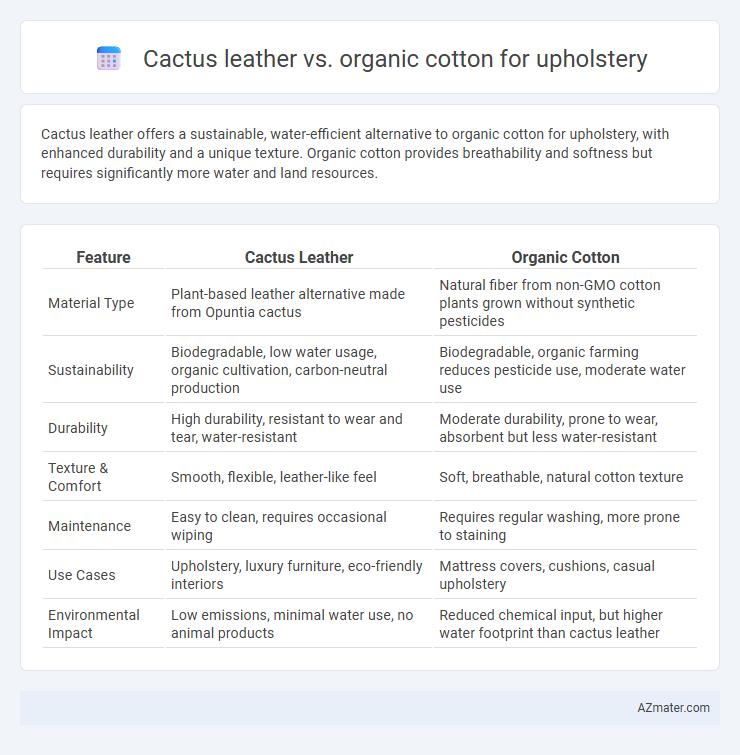Cactus leather offers a sustainable, water-efficient alternative to organic cotton for upholstery, with enhanced durability and a unique texture. Organic cotton provides breathability and softness but requires significantly more water and land resources.
Table of Comparison
| Feature | Cactus Leather | Organic Cotton |
|---|---|---|
| Material Type | Plant-based leather alternative made from Opuntia cactus | Natural fiber from non-GMO cotton plants grown without synthetic pesticides |
| Sustainability | Biodegradable, low water usage, organic cultivation, carbon-neutral production | Biodegradable, organic farming reduces pesticide use, moderate water use |
| Durability | High durability, resistant to wear and tear, water-resistant | Moderate durability, prone to wear, absorbent but less water-resistant |
| Texture & Comfort | Smooth, flexible, leather-like feel | Soft, breathable, natural cotton texture |
| Maintenance | Easy to clean, requires occasional wiping | Requires regular washing, more prone to staining |
| Use Cases | Upholstery, luxury furniture, eco-friendly interiors | Mattress covers, cushions, casual upholstery |
| Environmental Impact | Low emissions, minimal water use, no animal products | Reduced chemical input, but higher water footprint than cactus leather |
Introduction: Sustainable Upholstery Materials
Cactus leather offers a durable and eco-friendly alternative to traditional upholstery materials, leveraging renewable agave plant fibers that require minimal water and no pesticides. Organic cotton upholstery provides a natural, breathable fabric cultivated without harmful chemicals, reducing environmental impact through sustainable farming practices. Both materials contribute to sustainable interior design by minimizing resource consumption and promoting biodegradability in furniture production.
What is Cactus Leather?
Cactus leather is an innovative, sustainable material made from mature leaves of the Nopal cactus, processed into a durable, vegan alternative to animal leather. It exhibits high resistance to wear and tear, making it suitable for upholstery in furniture and automotive interiors, while requiring significantly less water and pesticides compared to organic cotton cultivation. Unlike organic cotton, which is a natural textile fiber grown from cotton plants and valued for its breathability, cactus leather offers a leather-like finish with a lower environmental impact due to its regenerative harvesting process.
Understanding Organic Cotton Upholstery
Organic cotton upholstery offers a sustainable and breathable alternative to traditional materials, providing natural softness and durability ideal for furniture use. Its cultivation avoids harmful pesticides and synthetic fertilizers, promoting eco-friendly farming practices that reduce environmental impact. Compared to cactus leather, organic cotton supports biodegradability and a more familiar textile texture, making it a preferred choice for eco-conscious consumers seeking comfort and sustainability in upholstery.
Environmental Impact: Cactus Leather vs Organic Cotton
Cactus leather significantly reduces water consumption and greenhouse gas emissions compared to organic cotton, as it is derived from the resilient Nopal cactus requiring minimal irrigation and no pesticides. Organic cotton, while avoiding synthetic chemicals, still demands substantial water use and large land areas, contributing to soil degradation and carbon emissions. Choosing cactus leather for upholstery supports sustainable resource use by lowering environmental footprint and promoting biodiversity preservation.
Durability and Longevity Comparison
Cactus leather offers superior durability for upholstery due to its resistance to wear, scratches, and fading, making it ideal for high-traffic areas. Organic cotton, while breathable and eco-friendly, tends to wear down faster and is more prone to staining and tearing under heavy use. Choosing cactus leather ensures longer-lasting furniture with minimal maintenance compared to the shorter lifespan of organic cotton upholstery.
Comfort and Aesthetics in Upholstery
Cactus leather offers a smooth, supple texture with a natural matte finish that enhances modern upholstered furniture's aesthetic appeal, providing a luxurious yet sustainable alternative to traditional leather. Organic cotton upholstery delivers exceptional breathability and softness, creating a cozy and inviting seating experience while supporting eco-friendly practices through chemical-free cultivation. Both materials balance comfort and style, with cactus leather excelling in durability and sleekness, whereas organic cotton emphasizes tactile warmth and natural charm.
Care and Maintenance Requirements
Cactus leather requires minimal care, needing only occasional wiping with a damp cloth, making it highly resistant to stains and water damage compared to organic cotton. Organic cotton upholstery demands regular vacuuming and prompt stain treatment to prevent dirt absorption and fabric wear. Both materials benefit from avoiding direct sunlight to preserve color and texture, but cactus leather offers superior durability and ease of maintenance in high-traffic areas.
Cost Analysis: Initial Investment and Long-Term Value
Cactus leather typically demands a higher initial investment than organic cotton due to its innovative processing techniques and premium sustainability appeal, often ranging from $50 to $100 per yard, compared to organic cotton's $15 to $40. Over time, cactus leather offers superior durability and moisture resistance, extending furniture lifespan and reducing replacement frequency, which translates to long-term cost savings despite the upfront expense. Organic cotton, while more affordable initially, tends to wear faster under heavy use, potentially increasing maintenance and replacement costs over its lifecycle.
Availability and Market Trends
Cactus leather is rapidly gaining traction in sustainable upholstery markets due to its eco-friendly production and durability, with availability increasing as startups expand supply chains across North America and Europe. Organic cotton remains widely accessible, supported by established global agricultural networks and certification systems that ensure consistent quality and demand among eco-conscious consumers. Market trends indicate a growing preference for innovative plant-based materials like cactus leather, although organic cotton continues to dominate due to cost-effectiveness and ease of integration in traditional upholstery manufacturing.
Which Is Better for Upholstery: Cactus Leather or Organic Cotton?
Cactus leather offers superior durability and water resistance compared to organic cotton, making it ideal for high-traffic upholstery and long-term use. Organic cotton excels in breathability and softness, providing comfort but requiring more frequent maintenance due to its susceptibility to stains and wear. For upholstery where longevity and easy cleaning are priorities, cactus leather is generally the better choice.

Infographic: Cactus leather vs Organic cotton for Upholstery
 azmater.com
azmater.com